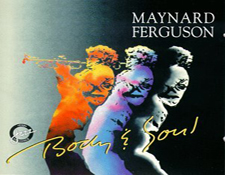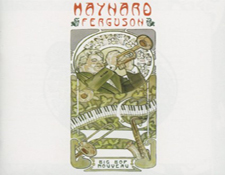It’s the time of year for saving money!
Y’know kids, fame is fleeting. So many artists spend their lives nurturing careers that hopefully ascend. They sometimes take curious, unexpected tangents which bring them mass success, only to disappear from public consciousness once the hits have faded, the PR and promotional budgets cut and public taste moved onto the next big thing.
 Take the case of Maynard Ferguson, the wonderful trumpet maestro commonly written off by hard core jazz folks for his trademark super high note playing. While at times the music could arguably border on gimmickry, like heavy metal guitar shredders — from Steve Vai to Yngwie Malmsteen — their talent is undeniable.
Take the case of Maynard Ferguson, the wonderful trumpet maestro commonly written off by hard core jazz folks for his trademark super high note playing. While at times the music could arguably border on gimmickry, like heavy metal guitar shredders — from Steve Vai to Yngwie Malmsteen — their talent is undeniable.
I studied trumpet as a kid, so Maynard was one of my early heroes, alongside Dizzy Gillespie and Clark Terry. I could never even remotely approach playing like any of them, much less squeal out high notes that would make canines perk up their ears. But I always appreciated what he brought to the table — whether you liked his music or not, you couldn’t mistake Maynard Ferguson’s sound for anyone else.
For those of you unfamiliar with Maynard’s work, he came up in the ranks in the early 1950s, hailing from Canada and joining in Stan Kenton’s bands. He won many Down Beat Magazine readers polls as best trumpeter. He worked on soundtracks while also putting out solo recordings on Mercury Records’ EmArcy jazz imprint and later on Roulette Records (among others). But it wasn’t until the 1970s that many of us “young folks” discovered Maynard when he signed to Columbia Records with his series of wonderful big-band-on-steroids jazz-rocks-fusion recordings under the “MF Horn” brand.
Perspective helps here too: this was a time when “horn bands” like Chicago and Blood Sweat & Tears were commonly played on the radio, having big hits with their jazz-flavored rock music.
 Maynard Ferguson rode that wave wisely, crossing over fans of that sound to more instrumentally based improvisational jazz performances. Maynard’s Live at Jimmy’s (MF Horn 4&5) was notable for its incendiary version of Jimmy Webb’s “MacArthur Park.” As the 70s moved along into funk and disco, so went Maynard and by the mid 70s he achieved a Top 25 pop album hit with the Conquistador album and the theme song to the smash hit movie Rocky — “Gonna Fly Now.”
Maynard Ferguson rode that wave wisely, crossing over fans of that sound to more instrumentally based improvisational jazz performances. Maynard’s Live at Jimmy’s (MF Horn 4&5) was notable for its incendiary version of Jimmy Webb’s “MacArthur Park.” As the 70s moved along into funk and disco, so went Maynard and by the mid 70s he achieved a Top 25 pop album hit with the Conquistador album and the theme song to the smash hit movie Rocky — “Gonna Fly Now.”
Maynard Ferguson’s music was everywhere you turned, and you really couldn’t fault the guy cause he was — ultimately — exposing the masses to jazz.
Then, seemingly just as fast as he ascended to pop stardom, he kinda disappeared. Punk and New Wave music captured the headlines. Young jazz bucks like Pat Metheny and Wynton Marsalis were wowing audiences and capturing the headlines in the music press.
I lost track of Maynard around this time as I suspect many of you did as well… The reality was he was alive and well, putting out numerous albums on a variety of independent labels and touring around, performing to passionate audiences.
All that said… the good folks at Omnivore Records have started a series of reissues of these late period gems, all of which sound real good as CDs go. This is fun stuff for driving around in your car and maybe even wowing some hep friends with high notes while downing your favorite artisanal craft beers.
 Big Bop Nouveau includes a super tight medley of Maynard’s hits (cheekily titled “The Maynard Ferguson Hit Medley”) including “Chameleon,” “MacArthur Park,” “Birdland” and others. His playing on this 1986 release is clearly undiminished, Maynard hitting those crazy wonderful high notes with such control it continues to astound.
Big Bop Nouveau includes a super tight medley of Maynard’s hits (cheekily titled “The Maynard Ferguson Hit Medley”) including “Chameleon,” “MacArthur Park,” “Birdland” and others. His playing on this 1986 release is clearly undiminished, Maynard hitting those crazy wonderful high notes with such control it continues to astound.
Knowing I had four Maynard Ferguson reissue CDs in my “to review” pile (courtesy of the good folks at Omnivore, full disclosure), I happened to find a used vinyl copy his 1983 indie release Live From San Francisco. Recorded at one of my favorite venues, The Great American Music Hall, this is a great performance. While the vinyl sounded good, knowing how sketchy a lot of these indie labels were back in the day — in business one day, gone tomorrow — locating a copy on that format might be more bother for most of you than its worth. Yes, the CD sounds a bit brighter than the LP, but that is to be expected in many ways; that said, I wasn’t hearing any big sonic red flags. Honestly, I’d never seen the album before and I am a pretty hard core crate digger (as we are known among the record collecting public)
So, yeah, the LPs are nice if you can find them but — y’know — for this kind of music, there is something about just putting on an hour-plus set of Maynard and letting him wail away vs. having to get up and switch sides. This is one of those instances where the long form format works to the music’s advantage.
Maynard’s 1982 release Storm is also featured in the Omnivore Records reissue series.
 If you are already a hardcore Maynard fan, chances are you probably have the original LPs already, but you may want to pick up the reissues as some have exclusive bonus tracks. For example, Body & Soul from 1986, features three additional songs and Be Bop Noveau has one extra tune too.
If you are already a hardcore Maynard fan, chances are you probably have the original LPs already, but you may want to pick up the reissues as some have exclusive bonus tracks. For example, Body & Soul from 1986, features three additional songs and Be Bop Noveau has one extra tune too.
There are many riches to be found in Maynard Ferguson’s catalog and these Omnivore reissues present a compelling portrait of an artist that didn’t stop pushing his envelope once the major label hits had run their course. Good stuff worth checking out.






